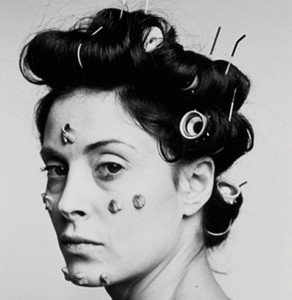art and change: art and feminism
Conversations surrounding the over-arching and increasingly redactive term Feminism in panel or group style setting, can tend to be focused on picking apart semantic terminology and deciphering the ideology’s dogmatic past. It can be frustrating when one is looking for more tangible answers to proposed prompts, in this case the intersection of binary concepts of Art and Feminism.
The panel discussion, held at The Wheeler Centre as part of their Art and Change series, was uneasy at times and undeniably tense in others. The presenter Jane Montgomery Griffiths, was interesting and witty, the perfect choice to chair such a dense topic. Griffiths helped to buoy what would otherwise have been a rather humourless exchange between the other panel members, artists Emily Floyd, Atlanta Eke, Mish Grigor and curator Juliana Engberg.
I’m critical of the panel form in general, which relies on invited panellists exchanging sound bite perfect concepts, with rarely enough time allowed to flesh out the nuances of an argument. As in this case, if perspectives held are vastly different the exchange can appear to be combative and defiant in its subjectivity.
The artists on the panel did not articulately flesh out their points, probably for myriad reasons as elucidated above, and it was frustrating to watch. In response to Griffith’s first question ‘what is your personal definition of Feminism,’ none bar Juliana Engberg gave a solid answer. Engberg linked her Feminism inextricably to Humanism, a view that resonates very strongly with my own.
As Engberg was the only member of the panel who trades exclusively in the explanation of conceptually dense ideas, this perhaps explains why her conversational flow and content was much more finely tuned than that of the rest of the panel. Her claim however, to being ‘gender blind’ for the entirety of her career felt absurdly defiant, and derailed the panel from a very early stage. As Engberg, the most objectively successful panel member- she is the current artistic director of ACCA- claims that she neither recognises nor considers gender to be an issue central to artistic practise, there was not much room for the rest of the panel to move.
There was a clear articulation that the personal politics of the panel were socialised very much of the time in which each were raised. This alone was relatively interesting to see unfold, as an illustrative demonstration of the structural problems inherent in Feminism as a globalised movement which supposedly can encompass the perspectives of all women. As was raised in the panel conversation, it is time for artists to move beyond a reliance on labelling their work as Feminist without inventing new forms or methods that add to the historical conversation. As Emily Floyd suggested, that ‘because women have been so excluded from the art world because of structural inequality, we have to expand the idea of what art is. All of the things that women do can be put inside art if we try to expand it.’
This is the best idea to emerge from the talk- that women should just get out there and make art, or invent new concepts of art- rather that spending too much of our time analysing the history of limitations for women. While this is true, we have crossed a threshold, where we have the opportunity to fulfil our potential as an act of defiance, celebration and excitement. This is where art can be exciting and revolutionary, and will represent the undeniably obvious ability of women to express themselves symbolically.
Let’s get out there and do it.
Art and Change: Art and Feminism took place at the Wheeler Centre, Melbourne on October 15. The event was presented in partnership with the Melbourne Festival.


